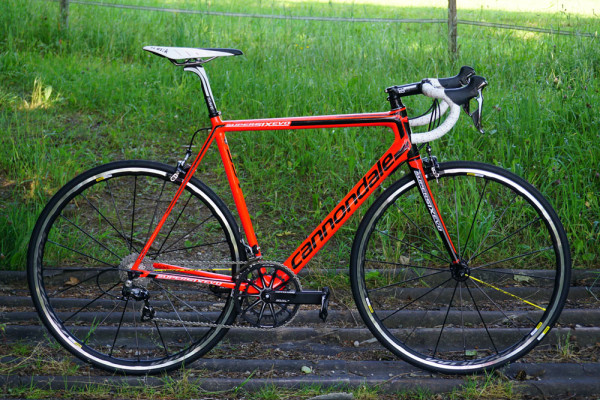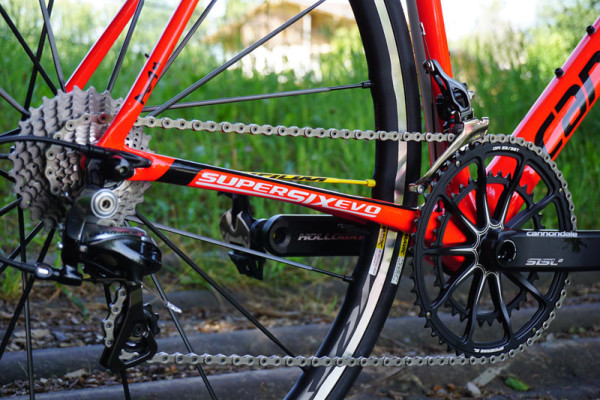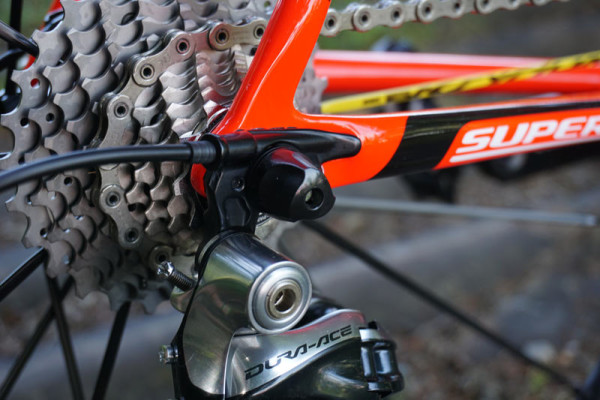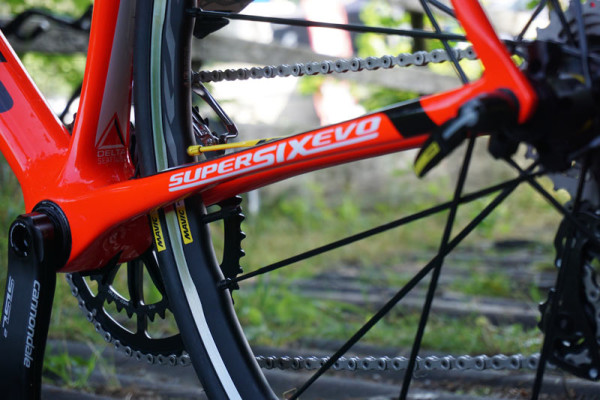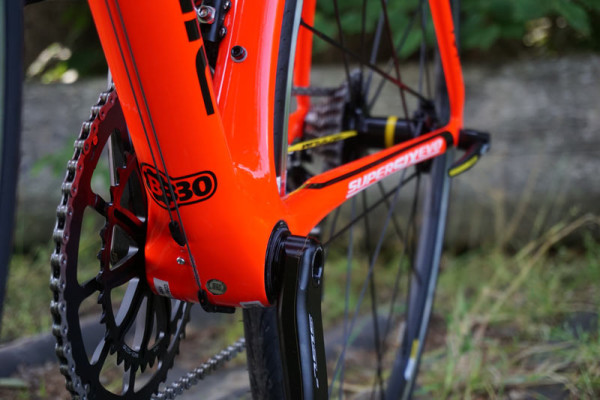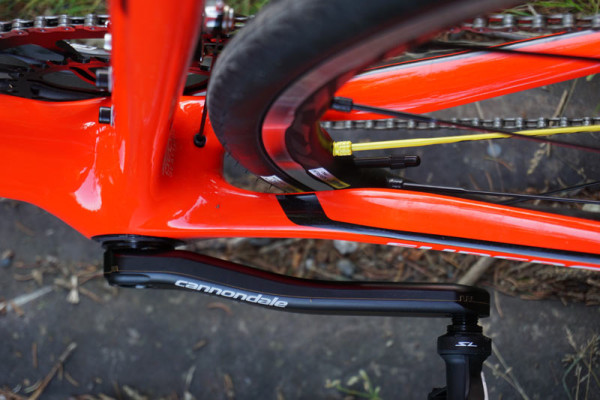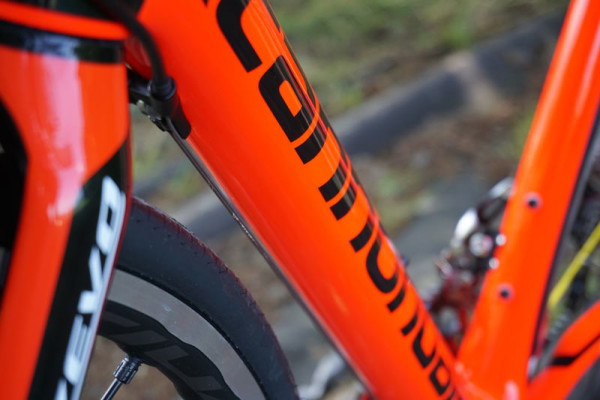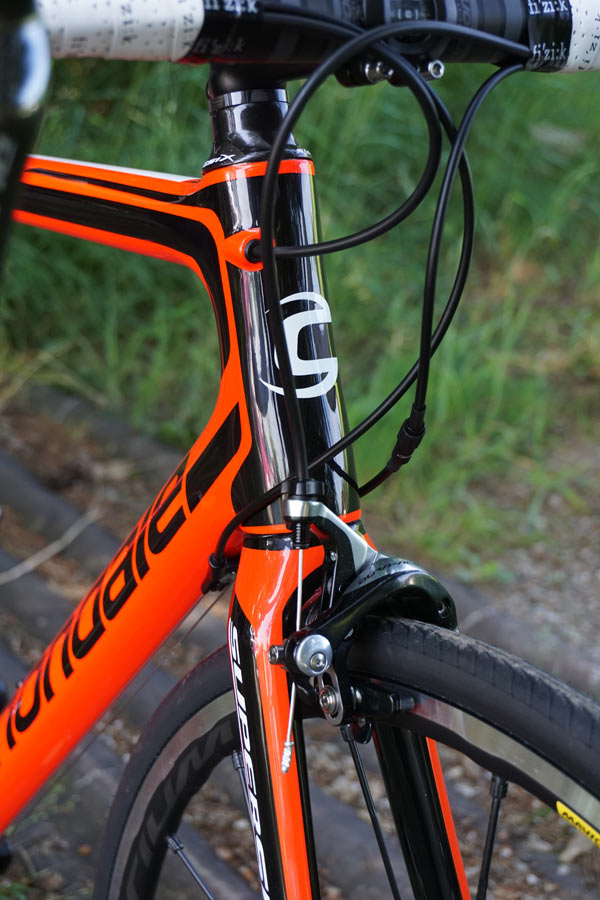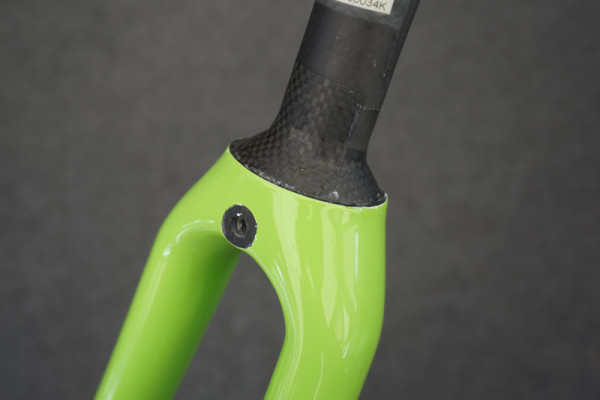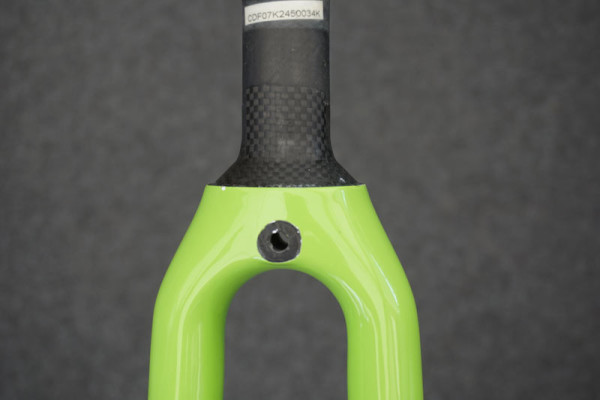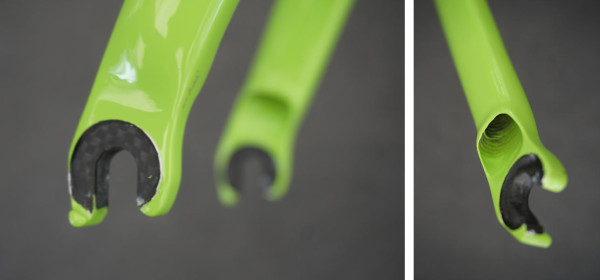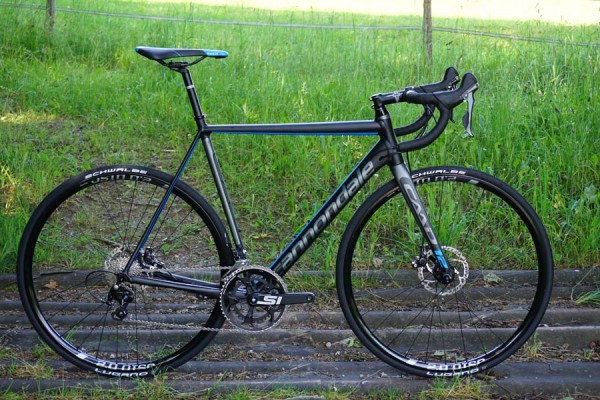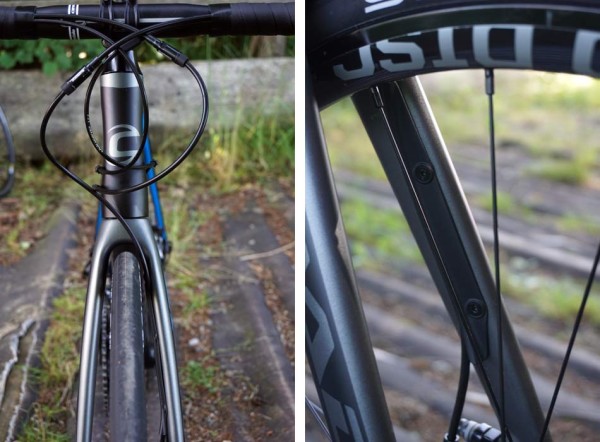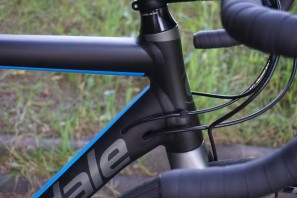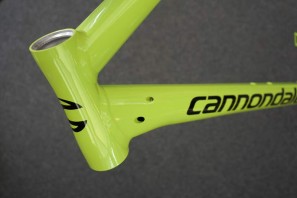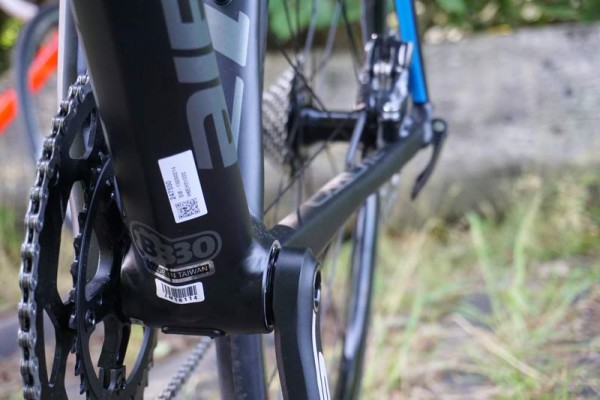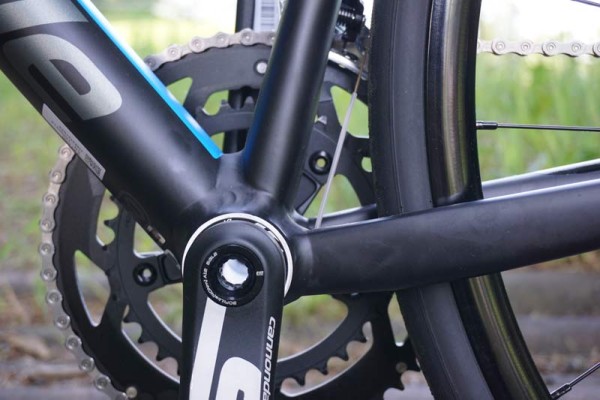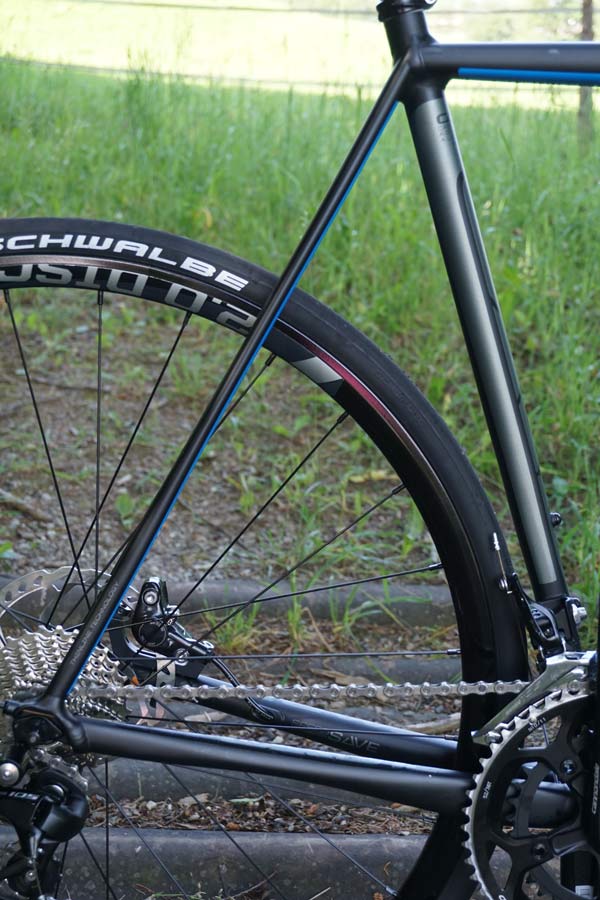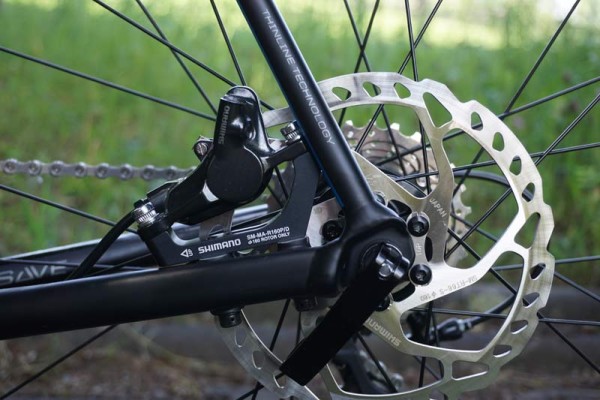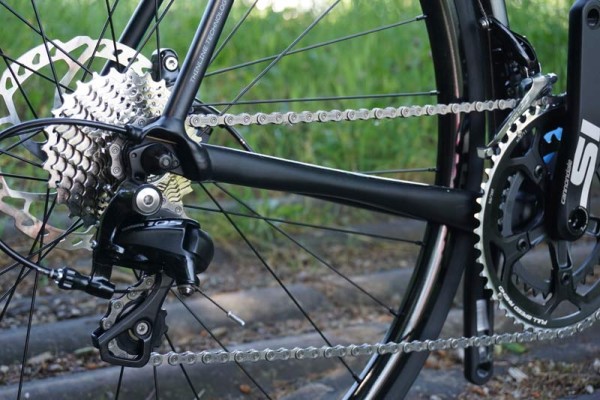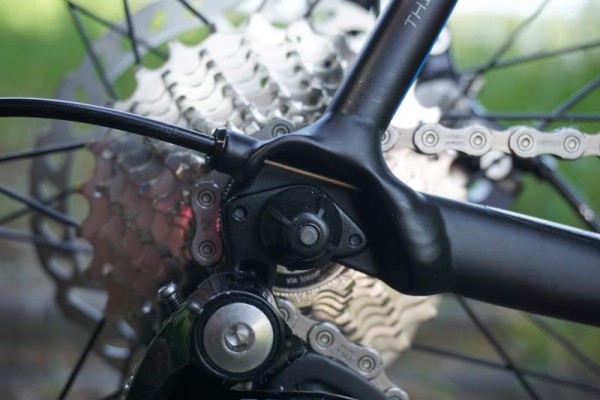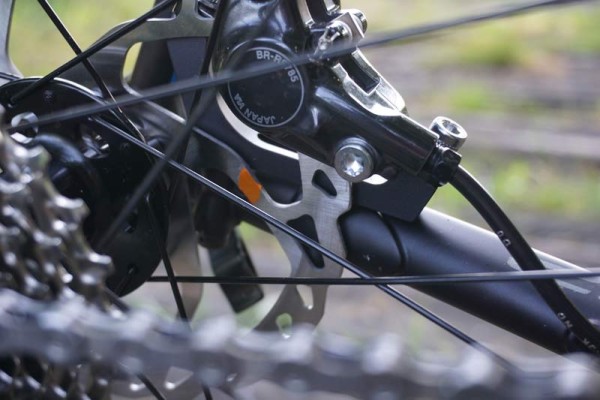Considering the prior Cannondale SuperSix EVO frame had already dipped below 700g and been successfully raced on the UCI grand tour circuit, they knew the next Evo would really have to do something big to make an improvement over the prior version.
Starting at the fork, they molded the lower bearing race into the crown, eliminating both the sharp bend to make it stronger and eliminating the need for an alloy part to save about 30g. And that’s just the beginning. Each side of the rear triangle is made in a single piece, with size specific layups for each size, saving weight by eliminating the overwrap required to join a separate dropout piece with separate tubes.
But the changes go beyond just saving weight. The BB is wider and asymmetric, pushing the non drive side out 5mm to make it 73mm. And the chainstays are flatter than ever to get 11% more compliance. It’s called the Balance of Power, offering more traction and comfort without sacrificing efficiency…
The seatstay, chainstay and rear dropouts are molded as a single piece with continuous fibers throughout. Across all the sizes and the separate left and right pieces, they’re using 16 different molds to make them.
The SpiderRing gets updated to a new 8-arm design that’s just 190g for the single-piece, dual-chainring 50/34 combo. It’s also available in a 52/36.
The cable exit assembly combines with the derailleur mount for a new design.
The seat tube and BB shell are molded as a single piece. Then, as the frame is assembled, a staggered layer of fiber sheets connect the chainstays to the BB shell by wrapping around it and up into the seat tube. The effect is a massively stiff BB section without limiting the chainstay’s ability to flex up and down.
The BB drop is 3.5mm lower and geometry is made for running 28c tires even though the bikes come stock with 700×25 rubber. Keep the 25s and you’ll have a lower center of gravity for better handling.
The flared base of the seat tube combined with the wider BB and asymmetric chainstays improve lateral stiffness by 11%.
The seatpost is now 25.4mm diameter and 180g, which let them use a thinner seat tube to save up to 30g. That’s combined with their flexible SAVE seatpost design and a flattened seat tube to provide 36% more seated comfort. Add that to the 15% more compliance offered by the stays and you may as well be riding on a cloud.
Shift cables were kept external at the request of pro team mechanics since this a race machine.
The headtube and other sections of the bike combine high- and ultra-high modulus carbons with standard fibers to create very stiff, strong sections without adding weight, and are able to tune the ride feel. The headtube also has a new hourglass shape. Net result is a 12% stiffer front end, without losing its character. All of the tubes on the bike change layup and size based on frame size, letting them offer a consistent ride feel across the range.
No modern race bike would be right without a little aerodynamic advantage, too, so they also gave the tubes and fork legs a bit of aero shaping. That, combined with revised water bottle placement, provided 60g of drag reduction for a 6 watt savings.
The new fork uses a continuous fiber, one-piece design that shapes the top of the crown into the bearing race. With carbon fiber, you don’t want sharp angles, so this not only makes for a stronger design but also saves weight since you won’t need to slide on an alloy bearing race.
It’s slightly tapered at 1-1/4″ to 1-1/8″ at the top.
The dropouts are also molded as a single piece with the fork, saving more weight, totaling 40g savings over prior model. The new design also gets 21% more fore/aft deflection, which helps it match the increased compliance of the rear end. The holes at bottom are to pull the bladder out after molding. The high end bikes will get the hi-mod fork, others get standard carbon forks from the same mold.
Altogether, the frame itself is actually 17g heavier, hitting the scales at a claimed 777g for a painted 56 with hardware. But, the system weight is 67g lighter than the prior version. Weight changes compared to prior model are:
- frame +17g
- fork -40g
- headset -14g
- seatpost -30g
The frameset (frame, fork, headset, seatpost) is a claimed 1,303g.
The model shown here is the SuperSix Evo Hi-Mod Dura-Ace 1, which gets a Cannondale cockpit with Fizik Arione R3 saddle, Mavic Ksyrium Pro wheels and a full Dura-Ace mechanical group. There are also Di2 and Ultegra versions with various similar parts. We’ll post a full run down of models and actual weights separately.
2016 CANNONDALE CAAD12 ALLOY ROAD BIKE
The other big news on the high end road bike front is the all-new CAAD12.
Cannondale’s rep said there were enough updates throughout the CAAD10’s life to justify the jump from 10 to 12. Plus, “11” would just get lost in all the current 11-speed marketing, and in our opinion 12 sounds better anyway.
The frame gets their usual assortment of Smart Forming, double welding and hydroforming, but it all gets refined. Many of the same features from the Evo are used here, too, like a 25.4 seatpost on the highest end models, asymmetric and flatter, and wider bottom bracket shell. The top of the line Black Inc model even gets the gets the hi-mod fork shown above. Others get the standard modulus fork.
It’ll come in rim and disc brake versions, we chose to highlight the disc model but will show the rim brake bikes in our weigh in post separately.
The fork looks stuffed with a 700×25 tire, but there was mention of running 28s if memory serves. The inside of the fork leg uses their bolt-on brake hose management. They said the overall layup and design of the disc fork was very similar to the rim brake version, just with the obvious reinforcements to handle the different braking stresses. No official word on its weight yet.
Smooth cable ports make for elegant entry and exit for shift and rear brake lines. Rim brake models will run the brake cable through the top tube and pop out the back of the seat tube like on the SuperSix.
The 73mm wide BB30 A is the same 5mm wider on the non-drive side as the carbon bike. It helps deliver the 13% better stiffness to weight ratio compared to the CAAD10 bike, and the fork has a whopping 30% better stiffness to weight ratio.
Some models will get their new Si cranks that are hollow forged to compete at the Ultegra price point but will be stiffer and compatible with their one-piece SpiderRing double chainring. Stock setup is two standard chainrings bolted to a spider, but you can save about 30g by upgrading to the SpiderRing.
It uses the Shimano flat mount brake standard…
…with a patented brake mount design that’s brass welded to the chainstay first, then drilled and tapped for the brake mounting holes. The benefit is weight savings and improved heat transfer, and it looks very smooth from the outside.
The rim brake bike’s chainstays are flatter than the disc brake model’s, but both get very flat seatstays to improve compliance by 50% in the rear triangle. It, too, gains 36% more compliance from the thinner seat tube, which should make this alloy bike like riding on, well, some sort of alloy cloud.
Slick.
Overall the changes saves about 236g off the prior CAAD10 disc bike’s system weight (frame, fork, headset, seatpost). The rim brake system weight is 200g lighter than before.
This bike replaces the CAAD10 as the top alloy model, next down will be the CAAD8. Full weights rundown coming soon.
